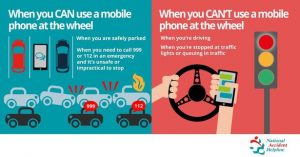Coming up with new ideas for digital PR campaigns can seem like a mind-boggling task. How do I create something that other people will really want to share, engage with and link to online?
These four fail-safe digital PR ideas are an excellent starting point for any successful campaign.
1. Make important information easier to digest
When the penalty for using a mobile phone while driving increased in 2017, government advice on when it was legal or illegal to use your phone while driving was available, but the details came across as dry and hard to remember. Working with a designer, we created an image for a client which made this information a lot easier to digest. This digital PR campaign generated 37 pieces of authoritative news coverage, including an article published by ITV.

2. Identify upcoming events and prepare relevant content
In the example above, it was vital to have the infographic ready to share with journalists, immediately before the law was updated. This meant having the foresight to ask the DfT when exactly the law was going to change, and planning far enough ahead to have everything signed off and ready to go in advance of that date. A simpler version of this process is using an awareness day calendar to prepare relevant content for specific, predictable events. Look for awareness days which are somehow relevant to your company so the campaign makes sense for readers. Other predictable events you can build digital PR campaigns around include seasonal changes and national holidays.
3. Carry out surveys or collect and share data from your own company
One of the best ways to generate a good, shareable headline is with fresh data. If you have the budget, commission a full survey on a topic which is a. relevant to your company and b. trending or otherwise of interest to people. Even better if you can get hold of statistically significant, regional data and generate an online, interactive map. If you’re on a strict budget, cheap ways to carry out a survey include promoted Twitter polls and one question Google Surveys. Another cheap way to get hold of headline-grabbing data is to use information your company already has access to. For example, perhaps there was an increase in specific types of enquiries following Brexit, or your customers began buying a particular product during a heatwave. If you’re able to put a fresh perspective on something that’s relatable to the general public, journalists will be interested.
4. National competitions
Branded competitions are a genius way to get media coverage for your business. While journalists can be reluctant to put a brand in the spotlight for its own sake, they’re much more happy to share news of a local person who’s won an award or is shortlisted in a national competition. Photo competitions can work particularly well for digital PR campaigns, as journalists are always keen to use great images to illustrate a story. Remember to share shortlisted entries while the competition is still running, and to include a link back to an onsite entry form – we’ve generated hundreds of authoritative links and pieces of coverage this way.
January 12, 2018
How to get press for your tech startup
April 10, 2018
How to get newspaper sites to link to you
March 21, 2018






